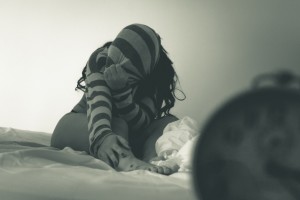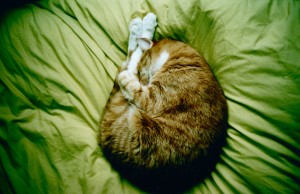
The Better Sleep Trial (BEST) was designed to determine if the proven efficacy of CBT for insomnia would hold true for adults with a diagnosis of a schizophrenia spectrum disorder. This was a pilot study, comparing 24 people receiving CBT and standard care to 26 people receiving standard care only.
The promising results of this soundly designed and well executed study deserve further consideration. Indeed, the authors are continuing with a larger study themselves and we can hopefully anticipate continued scientific rigour in a statistically more powerful study, which may lead to treatment improvements that significantly raise the quality of life for those suffering disturbed sleep alongside psychotic episodes.
Given the impact that disturbed and disordered sleep have on mental health, and the common co-morbidity of psychosis with sleep disorders, it seems surprising that no RCTs have been conducted to look at insomnia therapies for people with psychotic disorders. Although the authors conducted what seems to be a limited literature search, only using PubMed and the ISRCTN trial registry, my brief Google Scholar and Medline searches did not spring up any hidden gems. Baglioni & Riemann (2012) provide a brief summary of the mental health conditions where CBT for insomnia has been trialled as an additional treatment, but psychotic disorders are notably absent.
Several members of the author group had already carried out a smaller scale case series investigation of CBT for insomnia with fifteen people with delusions (Myers, Startup & Freeman, 2011).
The authors wanted to see if adding a CBT treatment for insomnia with proven clinical effectiveness would be efficacious for people with psychosis, and whether the additional CBT would provide more improvements in psychotic symptoms when compared to standard therapy. If these first two objectives were achieved, the authors hoped to see maintained levels of improvement at three months. It is not clear why three months was chosen as an appropriate time period for maintenance.

Sleep problems are common in psychosis, but studies of insomnia therapies for people with psychotic disorders are very thin on the ground.
Methods
The authors conducted the pilot as an intent-to-treat study, deliberately thinking about real-world generalisability and applicability (whether participants had good or poor treatment adherence, for example). Their sample was made of individuals with a schizophrenia or schizoaffective disorder diagnosis with a delusion or hallucination that had been present for at least three months causing distress rated as 2 or greater on the PSYRATS. Whilst this clinical profile evidently leads to a sample of people with active psychotic symptoms, it is not clear why consideration was not given to the frequency and loudness dimensions of the PSYRATS, since it is possible that these aspects of psychotic symptoms might be altered by sleep improvements. Participants also needed to be reporting moderate to high severity in sleep for a month or longer. The control and insomnia-treatment groups were balanced in terms of sex, psychosis and insomnia symptom levels.
A manualised CBT intervention was developed by the research team from other sources. The treatment period was 12 weeks, with a follow-up measurement appointment at 24 weeks. Insomnia group participants received at least four, and preferably eight, sessions of CBT for insomnia; the standard care is not described beyond it following national guidelines. Actigraphy was conducted to look at sleep times and quality. A substantial number of secondary outcome measures were conducted alongside the ISI and PSYRATS at the start, 12 week and 24 week time-points.
Results
- 23 of 24 insomnia group patients completed at least the minimum amount of CBT
- Considerable effect sizes for reduction in insomnia symptoms were found in the CBT group relative to the control group
- at 12 weeks (d=1.9)
- and 24 weeks (d=1.2)
- At a moderate effect size level, sleep quality was elevated in the CBT group relative to controls
- at 12 weeks (d=0.6)
- and 24 weeks (d=0.9)
- Small to moderate effect sizes were found for fatigue, quality of life and wellbeing at both timepoints
- However, there was no clear indication in this pilot study that CBT for insomnia had any impact, either positive or negative, on standard care outcomes for people with schizophrenia spectrum disorders. Whilst on the one hand this might be seen as disappointing, on the other hand it can be seen that the additional CBT did not have a generalised impact on mental health but a quite specific and positive effect on sleep disturbance problems.

Compared with control, this small pilot study showed considerable effect sizes of CBT for reducing insomnia symptoms in people with schizophrenia.
Where they will go next?
The authors are careful in their analysis, given the small study size and the exploratory nature of conducting a pilot, although they clearly feel that the results support continuing on to a larger trial. They will be using the experience to tweak the manualised sleep treatment for each individual. It is clear that measuring psychotic symptoms as a means of comparing two groups can be challenging, since individual experiences of psychosis vary so widely, but the authors will hope that having a larger sample will help to mitigate some of the problems of variance within each group.
The use of an actigraphy approach was seen as not ideal by participants nor the authors, but there are few ways of accurately measuring sleep timings that would be feasible in such a study. The suggestion of using actigraphy data in different ways is tentatively made and it will be interesting to see how the authors move forward with this in the larger study.
Quality of the research
This is a thoughtfully designed second-stage pilot study, presented as exploratory and as a learning exercise for a larger goal. Despite having generated some findings that would grab a headline, the authors commendably remain low-key and measured about their results. The paper is written clearly and accessibly for clinicians and academics alike.

A more powerful RCT is now needed to reproduce these results in a reliable way, before this evidence can have an impact on practice.
Links
Primary paper
Freeman, D. et al (2015) Efficacy of cognitive behavioural therapy for sleep improvement in patients with persistent delusions and hallucinations (BEST): A prospective, assessor-blind, randomised controlled pilot trial. Lancet Psychiatry
Other references
Baglioni, C. & Riemann, D. (2012). Cognitive-behavioural treatment for insomnia comorbid with psychiatric disorders. Sleep Disorders and Therapy, http://dx.doi.org/10.4172/2167-0277.1000e112.
Myers, E., Startup, H. & Freeman, D. (2011). Cognitive behavioural treatment of insomnia in individuals with persistent persecutory delusions: A pilot trial. Journal of Behavioural Therapy and Experimental Psychiatry, 42, 330-336.
Photo credits

Better Sleep Trial shows that #CBT may be promising treatment for #insomnia in ppl w active psychotic symptoms https://t.co/iHD0Lwn9XZ
Today @TheLancetPsych pilot RCT on quality of life for those suffering disturbed sleep alongside psychotic episodes https://t.co/iHD0Lwn9XZ
@Mental_Elf @TheLancetPsych better read that ,it’s about me :/
CBT for insomnia in people with active psychotic symptoms https://t.co/9OMkzLT5lE
Hi @ProfDFreeman Our blog on yr BEST study on sleep improvement in pts w persistent delusions & hallucinations https://t.co/iHD0Lwn9XZ
@Mental_Elf Thank you. v good to see. Hopefully treatment of sleep problems across mental health disorders will get more attention.
Promising pilot https://t.co/qaldPyE2Br @nhsmmhsct @sleepOTsophie looking at sleep, occupation and mental health too in the Trust
#CBT for #insomnia in people with active psychotic symptoms https://t.co/PAHJxNYOrQ
Pilot RCT suggests that CBT may reduce insomnia symptoms in people with schizophrenia https://t.co/iHD0Lwn9XZ
@Mental_Elf I’ll mention this on our CBT training today-how about that for up to the minute?
@CommLinksTrain @Mental_Elf Up to the minute indeed- Doesn’t surprise me from fantastic @CommLinksTrain trainers!
RT @Mental_Elf: Sleep problems are common in psychosis, but studies of insomnia therapies are very thin on the ground https://t.co/iHD0Lwn9…
Don’t miss: CBT for insomnia in people with active psychotic symptoms https://t.co/iHD0Lwn9XZ #EBP
Interesting how two of the ‘primary outcome’ measures of PSYRAT symptom scores for hallucinations and delusions are worse in the CBT than control group at follow-up and no better at end of trial.
As the authors say en passant “The wide confidence intervals
include the possibility that the treatment can either
reduce or increase delusions and hallucinations” – but as they clearly show…on average, the data reveal worsening!
Interesting how Keith Laws consistently applies the following rules when assessing CBT for psychosis:
If there is a non-significant effect in favour of CBT, it is a null finding.
If there is a non-significant effect against CBT, it is clear evidence of harm.
He needs to remove the plank from his eye, methinks.
By the way Keith, I remember on a twitter conversation with Joe Hayes and Alex Langford that you dismissed the positive results of the Avatar trial by claiming the PSYRATS cannot be rated blind. So is your rule something like the following:
If significant, positive results on PSYRATS, then must be caused by rater bias.
If non-significant negative results on PSYRATS, then must be evidence of harm.
How’s that plank doing?
Hi Keith, thank you for your observation. Whilst I can see your point to a degree, confidence intervals do serve an important function in moderating our interpretations to a more ‘real world’ view. Although we could potentially see a direction of movement here, it would be something to be interested in, but not a statistically significant finding. In terms of clinical significance, I think we would need more qualitative feedback to have a realistic means of interpretation. But that’s just my view – other views are definitely welcome!
Hi Sarah
Let me expand a little on why even non-significant findings of worse outcome with CBT are important here. The authors had hypotheses about possible *causal* mechanisms linking their CBT ‘sleep treatment’ with hallucinations and delusions – they say “Treatment of sleep problems in patients with psychosis might have another important benefit: reductions in delusions and hallucinations…[] If a causal link does exist, the clinical implication is that treatment of insomnia in patients with schizophrenia could lessen psychotic experiences, which would provide a new treatment route for these patients.” (p.976).
The patients were selected partly *because* of their hallucinations and delusions, the authors’ expressed an ambition to develop a treatment to potentially lessen psychotic experiences and finally, they used PSYRAT measures of these symptoms as *primary outcomes*. So, hallucinations and delusions were central to their model and it’s important to look in detail at what is happening here– not only because the means for both are in negative territory (significant or not) but because it fits with trends in data elsewhere.
The effect sizes here show worse outcomes of CBT vs. ‘standard care’ at follow-up both for hallucinations and for delusions (0.2 and 0.3). Crucially, the difference in outcomes for CBT vs controls on delusions and hallucinations increased from end-of-trial to follow-up on both symptoms and this is a worrying possible trend that needs further investigation over longer periods. Indeed, Prof Freeman has himself elsewhere recently reported worse PSYRAT delusion scores at follow-up after CBT vs. control http://www.sciencedirect.com/science/article/pii/S0920996414006070
As the authors rightly say, some effects may be non-significant because the trial ‘is insufficiently powered to detect anything but the largest effect sizes.” – and of course, a sufficiently powered trial might even detect ‘significant’ worsening of hallucination and delusion scores (although more likely to be ‘null’ I would venture). The problem is that CBTp is absolutely peppered with underpowered trials – making findings less reliable and hard to replicate. Underpowered trials will of course also raises questions about the reliability of large (significant) effects (e.g. insomnia) as well as the reliability of small (nonsignificant) effects e.g. hallucinations/delusions).
Unfortunately, follow-up data have not been meta-analysed for hallucinations, but a recent meta-analysis of follow-up data on CBT for delusions by Mehl et al (2015) reported an effect size of .25 or -.04 for CBT compared to TAU and active controls respectively – see http://journal.frontiersin.org/article/10.3389/fpsyg.2015.01450/abstract
Neither were significant, but again we see CBT taking delusions in negative territory– so, we do have some other evidence showing that CBT is not only ineffective with delusions, but may lead to worsening in some (albeit nonsignificant overall: vs active controls). One question might be to examine who worsens significantly within the group and why… and any failure to focus on these negative CBT data would be a disservice to patients.
Thank you Keith for your further response.
In answer to the general thrust of your reply, I can only concur about the paramount importance of safeguarding individuals receiving therapy and of sticking to the principle of ‘do no harm’. Trialling a new therapy through research similarly involves trying to stick to this principle, hence it is not ethical to run the initial trials of a treatment with large groups until enough is known to make this seem, on balance, a safe-enough piece of investigation. As we know, Freeman et al are hoping to now run a much larger study, given the findings of the first two pilots, but they needed to run the pilots first as part of a clinically, as well as methodologically, sound procedure.
Many studies do not get beyond the small sample pilot stage for all sorts of reasons, often to do with money and a disinclination to invest in work where the early signs are negative or equivocal. Your point about meta-analysis is a good one – I guess there would be a concern about how many small studies have not even made it to publication that don’t get included but some summation of findings has the potential to be very informative at a level of power that will be acceptable.
Is the size of the samples frustrating? In the sense of trying to progress clinical work, or to make sense of apparently undesirable outcomes, absolutely. And it is evident from your response how seriously you take patient welfare and how the effect size issue concerns you. I think many people reading on the Mental Elf would empathise, including those running small scale studies.
RT @Mental_Elf: Hi @Keith_Laws Please see a response to your comment from our blogger Sarah McDonald https://t.co/fkCtbx7n71 Any further th…
[…] despite the increasing number of studies trying to address causal ordering, there have been no sufficiently powered trials that explore […]